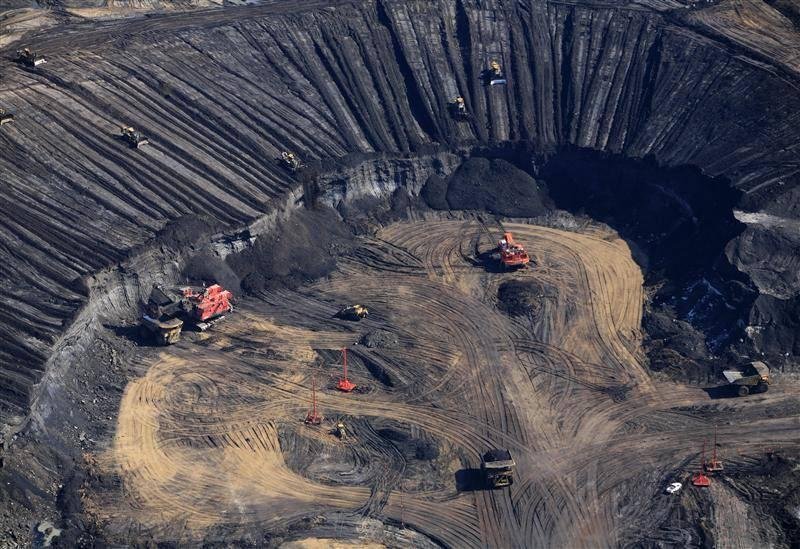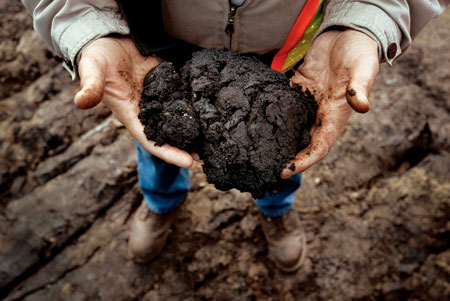Tar Sands

Tar Sands
Tar sands are the combination of sands, sandstones, or diatomaceous earth, saturated with relatively heavy hydrocarbon materials resembling low gravity crude petroleum. The tar sands are surveys of these deposits have revealed that they contain tremendous quantities of hydrocarbon materials very similar to low gravity crude petroleum and individual deposits have been estimated to contain the order of 60 to 70 million barrels of tar sand oil. Tar sands can be mined and processed to extract the oil-rich bitumen, which is then refined into oil. The bitumen in tar sands cannot be pumped from the ground in its natural state; instead tar sand deposits are mined, usually using strip mining or open pit techniques, or the oil is extracted by underground heating with additional upgrading.
Tar sands are mined and processed to generate oil similar to oil pumped from conventional oil wells, but extracting oil from tar sands is more complex than conventional oil recovery. Oil sands recovery processes include extraction and separation systems to separate the bitumen from the clay, sand, and water that make up the tar sand. Bitumen also requires additional upgrading before it can be refined. Because it is so viscous (thick), it also requires dilution with lighter hydrocarbons to make it transportable by pipelines.
Tar Sands Resources

A sand body that contains heavy hydrocarbon residues such as tar or asphalt, or degraded oil that has lost its volatile components. Hydrocarbons can be liberated from tar sand by heating and other processes, but tar sands, such as the Athabasca tar sand of Canada, are not commonly commercial because of high costs of production. Among some workers in the field of heavy oil, this term is falling out of use, in favor of the term “oil sand.”
Much of the world’s oil (more than 2 trillion barrels) is in the form of tar sand, although it is not all recoverable. While tar sands are found in many places worldwide, the largest deposits in the world are found in Canada (Alberta) and Venezuela, and much of the rest is found in various countries in the Middle East. In the United States, tar sand resources are primarily concentrated in Eastern Utah, mostly on public lands. The in-place tar sand oil resources in Utah are estimated at 12 to 19 billion barrels.
Application of tar sand
After mining, the tar sands are transported to an extraction plant, where a hot water process separates the bitumen from sand, water, and minerals. The separation takes place in separation cells. Hot water is added to the sand, and the resulting slurry is piped to the extraction plant where it is agitated. The combination of hot water and agitation releases bitumen from the oil sand and causes tiny air bubbles to attach to the bitumen droplets, that float to the top of the separation vessel, where the bitumen can be skimmed off. Further processing removes residual water and solids. The bitumen is then transported and eventually upgraded into synthetic crude oil.
The Tar Sands Industry
Currently, oil is not produced from tar sand on a significant commercial level in the United States; in fact, only Canada has a large-scale commercial tar sands industry, though a small amount of oil from tar sand is produced commercially in Venezuela. The Canadian tar sand industry is centered in Alberta, and more than one million barrels of synthetic oil is produced from these resources per day. Currently, tar sand represents about 40% of Canada’s oil production, and output is expanding rapidly. Approximately 20% of U.S. crude oil and products come from Canada, and a substantial portion of this amount comes from tar sand. The tar sands are extracted both by mining and in situ recovery methods (see below). Canadian tar sands are different than U.S. tar sand in that Canadian tar sands are water wetted, while U.S tar sands are hydrocarbon wetted. As a result of this difference, extraction techniques for the tar sand in Utah will be different than for those in Alberta.
Recently, prices for crude oil have again risen to levels that may make tar-sand-based oil production in the United States commercially attractive, and both government and industry are interested in pursuing the development of tar sand oil resources as an alternative to conventional oil.
Tar Sands Extraction and Processing
Tar sands deposits near the surface can be recovered by open pit mining techniques. New methods introduced in the 1990s considerably improved the efficiency of tar sands mining, thus reducing the cost. These systems use large hydraulic and electrically powered shovels to dig up tar sands and load them into enormous trucks that can carry up to 320 tons of tar sands per load.
After mining, the tar sands are transported to an extraction plant, where a hot water process separates the bitumen from sand, water, and minerals. The separation takes place in separation cells. Hot water is added to the sand, and the resulting slurry is piped to the extraction plant where it is agitated. The combination of hot water and agitation releases bitumen from the oil sand and causes tiny air bubbles to attach to the bitumen droplets, that float to the top of the separation vessel, where the bitumen can be skimmed off. Further processing removes residual water and solids. The bitumen is then transported and eventually upgraded into synthetic crude oil.
About two tons of tar sands are required to produce one barrel of oil. Roughly 75% of the bitumen can be recovered from sand. After oil extraction, the spent sand and other materials are then returned to the mine, which is eventually reclaimed.
In-situ production methods are used on bitumen deposits buried too deep for mining to be economically recovered. These techniques include steam injection, solvent injection, and fire floods, in which oxygen is injected and part of the resource burned to provide heat. So far steam injection has been the favoured method. Some of these extraction methods require large amounts of both water and energy (for heating and pumping).
Both mining and processing of tar sands involve a variety of environmental impacts, such as global warming and greenhouse gas emissions, disturbance of mined land; impacts on wildlife and air and water quality. The development of a commercial tar sands industry in the U.S. would also have significant social and economic impacts on local communities. Of special concern in the relatively arid western the United States is a large amount of water required for tar sands processing; currently, tar sands extraction and processing require several barrels of water for each barrel of oil produced, though some of the water can be recycled.
Another solvent extraction process for tar sands is disclosed wherein a low boiling solvent having a normal boiling point of from 20° to 70° C. is used to extract tar sands. The solvent is mixed with tar sands in a dissolution zone, the solvent: bitumen weight ratio being maintained at from about 0.5:1 to 2:1. This mixture is passed to a separation zone in which bitumen and inorganic fines are separated from extracted sand, the separation zone containing a classifier and countercurrent extraction column. The extracted sand is introduced into a first fluid-bed drying zone fluidized by heated solvent vapors, so as to remove unbound solvent from extracted sand while at the same time lowering the water content of the sand to less than about 2 wt. %. The so-treated sand is then passed into a second fluid-bed drying zone fluidized by a heated inert gas to remove the bound solvent. Recovered solvent is recycled to the dissolution zone.

